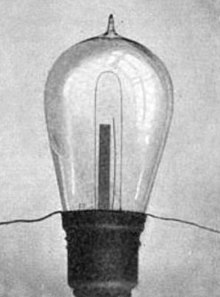Edison-Richardson Effect
The Edison-Richardson effect (also glow-electric effect , glow emission , thermionic emission , Edison effect or Richardson effect ) describes the emission of electrons from a heated hot cathode (usually in a vacuum ). The minimum temperatures are above 900 K and depend heavily on the material of the surface.
General
The electrons overcome the characteristic due to their thermal energy work function of the metal or the oxide layer. If the free electrons are not extracted by an electric field , they form a space charge cloud around the hot cathode in a vacuum and charge nearby electrodes negatively compared to the “cathode”. This effect can be used for the direct conversion of thermal energy into electrical energy. The efficiency of this thermionic generator is, however, low.
For technical applications, efforts are made to keep the required temperature of the hot cathode as low as possible by using materials with a low work function. This led to the development of the oxide cathode .
history
The effect was first described by Frederick Guthrie in 1873 . He discovered that a positively charged electroscope is discharged if you bring a grounded, glowing piece of metal near it. With a negatively charged electroscope, nothing happens, which means that glowing metal can only give off a negative charge.
Thomas Edison rediscovered this phenomenon in 1880 during experiments with incandescent lamps and in 1883 applied for a patent for an application based on it. Between 1882 and 1889, Julius Elster and Hans Friedrich Geitel systematically examined the charge given off by a hot wire. The saturation current density was computed in 1901 by Owen Willans Richardson in the Richardson equation, for which he was awarded the Nobel Prize in Physics in 1928 .
Richardson's equation
The Richardson equation describes the current density J of the electrons emerging from a metal at high temperatures. it is
- ,
here T is the absolute temperature , W e the release work for electrons, k B the Boltzmann constant and A the Richardson constant .
The work of release for electrons is generally around 1–6 eV . The Richardson constant depends primarily on the metal used and on the surface properties and is just under . For metal oxides it is much lower.
According to Saul Dushman (1883–1954), the Richardson constant can be estimated as follows:
Here m and e are the electron mass or elementary charge and k B and h are the Boltzmann and Planck constants, respectively . the equation
is also known as the Richardson-Dushman equation .
A correction term for the work function results from the Schottky effect when the field strength is very high . In this work area one speaks of Schottky emission .
Applications
The glow emission is used to generate free electrons in electron tubes. In a highly evacuated vessel, an (electron) current flows between the directly or indirectly heated hot cathode and the anode, which can be controlled by grids in between. Electron tubes enable the amplification of electrical signals, in the audio frequency range and in the high frequency range, in transmitters and receivers. Electron tubes made it possible to transmit not only Morse code , but also speech, music and images.
The CRT (Braun tube) consists of an electron source with a subsequent deflection. Applications:
- for electron beam melting and electron beam evaporation and electron beam welding, also in the scanning electron microscope .
- with a fluorescent screen as a picture tube in old televisions and oscilloscopes .
Hot cathode fluorescent lamps also use incandescent emission. In many other gas discharge lamps and also carbon arc lamps , the electrodes heat up to such an extent that glow emissions play a role. However , this is not the case with cold cathode tubes such as fluorescent tubes or glow lamps or with flash tubes .
Glow emission continues to be used in thyratrons , magnetrons , klystrons , traveling wave tubes, and vacuum fluorescent displays. Here, too, it serves to generate free electrons.
With the help of thermionic emission can work function are determined. However, the electric field , which is required to remove the electrons from the cathode , influences it, so that the measured current has to be extrapolated to the field strength .
Adverse effects of glow emission
In contrast, glow emission is undesirable in the case of control grids of electron tubes (i.e. when the grid glows due to heating), here it leads to so-called grid emission and to an obstructive grid current that can shift the operating point . Power tubes are therefore usually provided with cooling fins (radiation cooling) at the ends of the lattice support rods; the latter are usually made of copper for good heat conduction.
With switches, the glow emission between the switching contacts leads to the undesired switching arc , which must be extinguished by suitable technical measures to avoid damage .
Related effects
- Outside photo effect
- Field emission
Web links
Individual evidence
- ↑ Felix Auerbach: Electricity and Magnetism . In: Felix Auerbach (ed.): History of the development of modern physics: At the same time, an overview of your facts, laws and theories . Springer, Berlin, Heidelberg 1923, ISBN 978-3-642-50951-3 , pp. 241-278, 263 , doi : 10.1007 / 978-3-642-50951-3_16 .
- ↑ Patent US307031 : Electrical Indicator. Published October 21, 1884 , inventor: TA Edision.
- ^ A b Owen W. Richardson: Thermionic phenomena and the laws which govern them . December 12, 1929 ( nobelprize.org [PDF] Nobel Prize Lecture).
- ^ Saul Dushman: Electron Emission from Metals as a Function of Temperature . In: Phys. Rev. Band 21 , no. 6 , 1923, pp. 623-636 , doi : 10.1103 / PhysRev.21.623 .
- ^ Neil W. Ashcroft, N. David Mermin: Solid State Physics . Saunders College Publishing, New York 1976, ISBN 0-03-083993-9 , pp. 362-364 .






